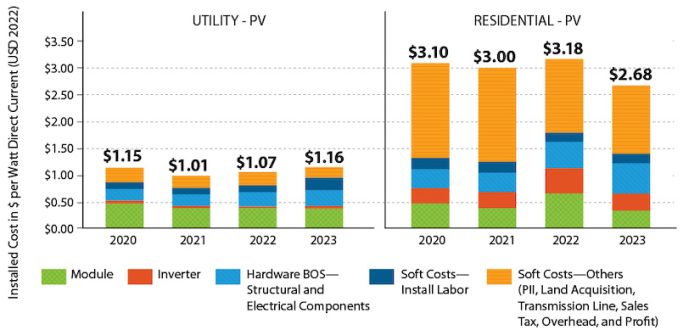
Residential solar PV system cost benchmarks are lower than ever, according to the National Renewable Energy Laboratory (NREL). Reasons include lower solar module prices and the impact of domestic manufacturing incentives.
NREL recently published its annual cost breakdown of installed solar photovoltaic (PV) and battery storage systems. The U.S. Solar Photovoltaic System and Energy Storage Cost Benchmarks, With Minimum Sustainable Price Analysis: Q1 2023 details installed costs for PV and storage systems as of the first quarter (Q1) of 2023.
Many of the trends that characterized the 2022 benchmarks—including high and volatile component prices and competition for limited supplies—appeared to lessen in 2023, according to NREL analysis.
Compared to last year’s report, modeled market prices for installed residential PV systems were 15% lower this year. Although balance of system costs were higher, those increased costs were more than offset by lower module, inverter, logistics, and customer acquisition costs, resulting in overall cost reductions for the representative residential system.

How long solar module prices stay this low, and how much you should be chasing those low prices is an open question – but regardless
Utility-scale isn’t as lucky.
Modeled market prices for utility-scale systems were 8% higher in Q1 2023 than in Q1 2022, according to the report, citing higher inverter, labor, and electrical balance of system (EBOS) costs that more than offset lower module, structural balance of system (SBOS), and other soft costs in the 2023 report.
“The costs of network upgrades needed to meet interconnection requirements have risen rapidly as the number of projects in the interconnection queue has increased,” said the report’s lead author, Vignesh Ramasamy. “Including network upgrade costs is one way we improved our model this year, and those costs account for much of the increase in EBOS costs compared with last year.”
IRA impact
NREL points to the impact of Inflation Reduction Act (IRA) tax incentives for domestic U.S. manufacturers.
“Numerous U.S. manufacturers are likely taking advantage of the IRA’s Section 45X Advanced Manufacturing Production Tax Credit,” which NREL analysts took into account. This plays out in two different ways:
“At one extreme, a U.S. manufacturer who receives the credit could pass the entire value to the buyer as a lower component price,” NREL says. “At the other, the manufacturer could leave the price unchanged and retain the entire credit as part of their margin.”
NREL analysts split the difference when modeling the effects of the tax credit on domestically produced components, assuming half of each credit was passed to installers and half was retained by manufacturers.
For further detail and context on how the manufacturing tax credits could be affecting costs, definitely check out the full report.
— Solar Builder magazine

Leave a Reply
You must be logged in to post a comment.